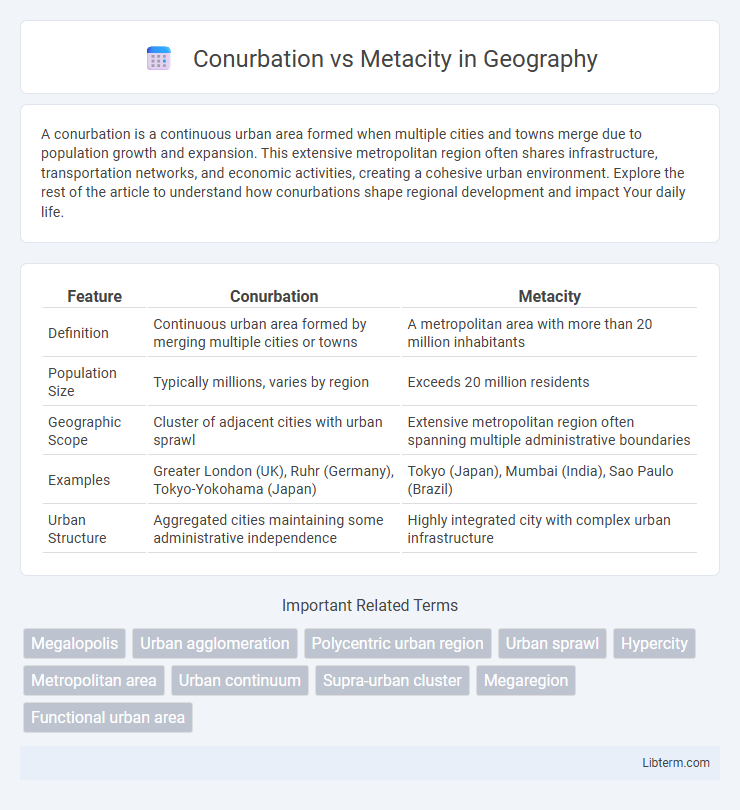A conurbation is a continuous urban area formed when multiple cities and towns merge due to population growth and expansion. This extensive metropolitan region often shares infrastructure, transportation networks, and economic activities, creating a cohesive urban environment. Explore the rest of the article to understand how conurbations shape regional development and impact Your daily life.
Table of Comparison
| Feature | Conurbation | Metacity |
|---|---|---|
| Definition | Continuous urban area formed by merging multiple cities or towns | A metropolitan area with more than 20 million inhabitants |
| Population Size | Typically millions, varies by region | Exceeds 20 million residents |
| Geographic Scope | Cluster of adjacent cities with urban sprawl | Extensive metropolitan region often spanning multiple administrative boundaries |
| Examples | Greater London (UK), Ruhr (Germany), Tokyo-Yokohama (Japan) | Tokyo (Japan), Mumbai (India), Sao Paulo (Brazil) |
| Urban Structure | Aggregated cities maintaining some administrative independence | Highly integrated city with complex urban infrastructure |
Understanding Conurbation: Definition and Characteristics
Conurbation refers to a large urban area formed by the continuous merging of multiple cities, towns, or suburbs, creating a sprawling, interconnected metropolitan region. It is characterized by shared infrastructure, economic integration, and seamless transportation networks that blur individual city boundaries. Unlike a metacity, which is typically defined by extreme population density and size, conurbations emphasize functional cohesion and urban expansion across administrative borders.
What is a Metacity? Key Features Explained
A metacity refers to an exceptionally large urban area with a population exceeding 20 million people, characterized by complex infrastructure and multiple interconnected metropolitan regions. Key features of a metacity include extensive economic integration, high-density development, and significant challenges related to governance, transportation, and environmental sustainability. Unlike conurbations, which are clusters of adjacent cities, metacities represent a hyper-urbanized megaregion that operates as a single socio-economic entity.
Historical Development: Conurbations vs. Metacities
Conurbations historically emerged from the merging of adjacent cities and towns driven by industrialization and transportation advancements during the 19th and early 20th centuries. Metacities represent a more recent urban phenomenon characterized by extensive urban networks spanning multiple metropolitan regions, often influenced by globalization and technological integration in the late 20th and early 21st centuries. The development of conurbations usually reflects regional economic integration, while metacities demonstrate complex, transregional urban connectivity and multifunctional economic systems.
Population Density and Urban Scale Comparison
Conurbations consist of multiple neighboring cities and towns merging into a single continuous urban area with moderately high population density, typically ranging from 1,000 to 4,000 people per square kilometer. Metacities represent larger urban agglomerations exceeding 20 million inhabitants, exhibiting extreme urban scale and population densities often surpassing 10,000 people per square kilometer. The key difference lies in metacities' sheer size and density, combining vast metropolitan expanse with megacity-level population concentrations, whereas conurbations maintain smaller scale and relatively lower density.
Governance and Administrative Challenges
Conurbations face governance challenges due to overlapping jurisdictions among multiple municipalities, requiring coordinated policies for transportation, infrastructure, and public services. Metacities, often encompassing vast populations exceeding 20 million, present complex administrative issues involving decentralized governance structures and the need for integrated urban planning across diverse districts. Efficient management in both scenarios demands innovative frameworks to balance local autonomy with regional cohesion, addressing disparities and ensuring sustainable development.
Economic Impacts: Growth and Opportunities
Conurbations generate significant economic growth by integrating multiple urban economies, fostering diverse industries, and expanding labor markets, which boosts productivity and innovation. Metacities, characterized by populations exceeding 20 million, amplify economic opportunities through global connectivity, attracting multinational corporations, and facilitating large-scale infrastructure investments. Both urban forms stimulate regional development but metacities drive higher economic output due to their sheer scale and complexity, supporting advanced service sectors and international trade hubs.
Infrastructure Demands in Conurbations and Metacities
Conurbations require integrated infrastructure systems to support interconnected urban areas, emphasizing efficient transportation networks, water supply, and waste management to handle high population densities. Metacities face even more complex infrastructure demands, necessitating advanced smart city technologies, extensive energy grids, and scalable public services to accommodate populations exceeding 20 million. Both urban forms must prioritize sustainable infrastructure investments to mitigate congestion, pollution, and resource depletion while ensuring resilient growth.
Social Dynamics and Urban Lifestyles
Conurbations exhibit interconnected urban areas where diverse social groups merge, fostering hybrid urban lifestyles shaped by shared resources and commuting patterns. Metacities, characterized by sprawling megaregions, promote complex social dynamics marked by economic stratification and varied cultural enclaves influencing lifestyle segmentation. Urban planners must address challenges in social cohesion and service distribution to enhance quality of life in both conurbations and metacities.
Environmental Implications: Sustainability Issues
Conurbations generate extensive urban sprawl that exacerbates pollution, habitat loss, and resource depletion due to high population density and continuous development. Metacities, with populations exceeding 20 million, intensify sustainability challenges like waste management, air quality degradation, and energy consumption, requiring advanced infrastructure and innovative policies. Both urban forms demand integrated environmental planning to mitigate carbon footprints and promote sustainable urban ecosystems.
Future Trends: Urbanization and the Rise of Metacities
Rapid urbanization is driving the transformation of traditional conurbations into sprawling metacities characterized by populations exceeding 20 million residents. Future trends indicate that metacities will emerge as global economic, cultural, and technological hubs, fueled by advancements in infrastructure, smart city technologies, and sustainable urban planning. The rise of metacities demands innovative governance models and integrated transportation systems to manage the challenges of density, resource allocation, and environmental impact effectively.
Conurbation Infographic

 libterm.com
libterm.com